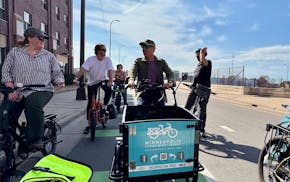Faced with threats from Uber and Lyft to exit — Ubxit? — the city on May 1, the Minneapolis City Council plans to wait until summer before it requires rideshare companies to pay drivers a minimum wage.
This buys Minnesotans more time to figure out who will pick us up when Uber and Lyft let us down.
A whole crop of startups have approached city officials, mounting challenges to established rideshares and the dictionary. MOOV. Hich. Pikapp. Wridz.
But maybe Minneapolis' hottest new rideshare is its oldest: Get ready to ride the Büs.
Metro Transit has everything. Wheels. An app. Drivers who earn a living wage.
Braced for Ubxit, I hopped on a bus Thursday morning, headed for downtown Minneapolis.
When I lived in south Minneapolis, I took light rail or biked to work almost every day. When I lived downtown, I walked to work. But now there's a river between downtown Minneapolis and me — and figuring out which of the eight bus stops within two blocks of my house would get me across the Mississippi seemed like a hassle.
Readers, I am here to report that the commute was not, in fact, a hassle. I plugged my address and my destination into the Metro Transit trip planner. It told me where to go, when the next bus would arrive and how long the whole trip should take. The bus was quiet and friendly and the driver was patient while I waved my phone at every surface except the ticket reader.
I've heard nothing good about the light rail since the pandemic, so I half expected the Blue Line to be actively on fire when I hopped aboard.
Readers, it was noisy but it was fine. Nobody was shooting up. Nobody was pooping on the seats. Online comment sections may have left me with unrealistic light-rail expectations. I settled back for the thrill of speeding past all the cars waiting at all the red lights on Hiawatha Avenue. Gridlock is for people who don't ride the rails.
The midmorning trip downtown cost two bucks and involved one transfer to the Blue Line. It took about 40 minutes — 15 of which were spent waiting for the train on a sunny bench.
I could have driven downtown and parked in half the time, at five times the cost.
If I hailed an Uber, it would have run me somewhere between $15 and $27 at that time of day. But I don't think I'll be using Uber anytime soon. Companies that pay their CEOs $24 million don't get to whine about minimum wages for drivers.
Is the bus perfect? Nah. The fact that Uber and Lyft were able to tie the entire state in knots exposes huge gaps in our transportation infrastructure. It would be nice if there were more routes, more buses, more trains, more taxis, more bike paths, more rideshares and more car-shares to get us where we're going.
But come July 2, the bus will be there for us. Even if Uber and Lyft are nowhere to be found.

Brooks: America mints its last penny. What's the new going rate for our thoughts?

Brooks: From big beavers to little bears, meet Minnesota's newest state symbols

Brooks: Kristi Noem's 'Hunger Games'? It could actually happen.

Brooks: Will American tourists abroad be welcome, or at least tolerated? I found out.


